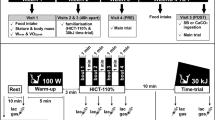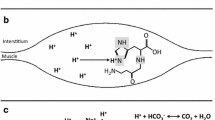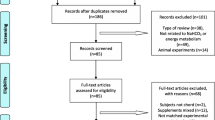Abstract
The oral ingestion of β-alanine, the rate-limiting precursor in carnosine synthesis, has been shown to elevate the muscle carnosine content. Carnosine is thought to act as a physiologically relevant pH buffer during exercise but direct evidence is lacking. Acidosis has been hypothesised to influence oxygen uptake kinetics during high-intensity exercise. The present study aimed to investigate whether oral β-alanine supplementation could reduce acidosis during high-intensity cycling and thereby affect oxygen uptake kinetics. 14 male physical education students participated in this placebo-controlled, double-blind study. Subjects were supplemented orally for 4 weeks with 4.8 g/day placebo or β-alanine. Before and after supplementation, subjects performed a 6-min cycling exercise bout at an intensity of 50% of the difference between ventilatory threshold (VT) and \( \dot{V}{\text{O}}_{2{\text{peak}}} \). Capillary blood samples were taken for determination of pH, lactate, bicarbonate and base excess, and pulmonary oxygen uptake kinetics were determined with a bi-exponential model fitted to the averaged breath-by-breath data of three repetitions. Exercise-induced acidosis was significantly reduced following β-alanine supplementation compared to placebo, without affecting blood lactate and bicarbonate concentrations. The time delay of the fast component (Td1) of the oxygen uptake kinetics was significantly reduced following β-alanine supplementation compared to placebo, although this did not reduce oxygen deficit. The parameters of the slow component did not differ between groups. These results indicate that chronic β-alanine supplementation, which presumably increased muscle carnosine content, can attenuate the fall in blood pH during high-intensity exercise. This may contribute to the ergogenic effect of the supplement found in some exercise modes.


Similar content being viewed by others
References
Abe H (2000) Role of histidine-related compounds as intracellular proton buffering constituents in vertebrate muscle. Biochemistry (Mosc) 65:757–765
Baguet A, Reyngoudt H, Pottier A, Everaert I, Callens S, Achten E, Derave W (2009) Carnosine loading and washout in human skeletal muscles. J Appl Physiol 106:837–842
Bate Smith EC (1938) The buffering of muscle in rigor; protein, phosphate and carnosine. J Physiol (Lond) 92:336–343
Begum G, Cunliffe A, Leveritt M (2005) Physiological role of carnosine in contracting muscle. Int J Sport Nutr Exerc Metab 15:493–514
Berger NJ, McNaughton LR, Keatley S, Wilkerson DP, Jones AM (2006) Sodium bicarbonate ingestion alters the slow but not the fast phase of VO2 kinetics. Med Sci Sports Exerc 38:1909–1917
Boldyrev AA, Petukhov VB (1978) Localization of carnosine effect on the fatigued muscle preparation. Gen Pharmacol 9:17–20
Derave W, Ozdemir MS, Harris RC, Pottier A, Reyngoudt H, Koppo K, Wise JA, Achten E (2007) Beta-alanine supplementation augments muscle carnosine content and attenuates fatigue during repeated isokinetic contraction bouts in trained sprinters. J Appl Physiol 103:1736–1743
Dutka TL, Lamb GD (2004) Effect of carnosine on excitation–contraction coupling in mechanically-skinned rat skeletal muscle. J Muscle Res Cell Motil 25:203–213
Forbes SC, Raymer GH, Kowalchuk JM, Marsh GD (2005) NaHCO3-induced alkalosis reduces the phosphocreatine slow component during heavy-intensity forearm exercise. J Appl Physiol 99:1668–1675
Gaesser GA, Poole DC (1996) The slow component of oxygen uptake kinetics in humans. Exerc Sport Sci Rev 24:35–71
Harris RC, Marlin DJ, Dunnett M, Snow DH, Hultman E (1990) Muscle buffering capacity and dipeptide content in the thoroughbred horse, greyhound dog and man. Comp Biochem Physiol A Physiol 97:249–251
Harris RC, Tallon MJ, Dunnett M, Boobis L, Coakley J, Kim HJ, Fallowfield JL, Hill CA, Sale C, Wise JA (2006) The absorption of orally supplied beta-alanine and its effect on muscle carnosine synthesis in human vastus lateralis. Amino Acids 30:279–289
Hayashi N, Ishihara M, Tanaka A, Yoshida T (1999) Impeding O(2) unloading in muscle delays oxygen uptake response to exercise onset in humans. Am J Physiol 277:R1274–R1281
Heck KL, Potteiger JA, Nau KL, Schroeder JM (1998) Sodium bicarbonate ingestion does not attenuate the VO2 slow component during constant-load exercise. Int J Sport Nutr 8:60–69
Hill CA, Harris RC, Kim HJ, Harris BD, Sale C, Boobis LH, Kim CK, Wise JA (2007) Influence of beta-alanine supplementation on skeletal muscle carnosine concentrations and high intensity cycling capacity. Amino Acids 32:225–233
Hultman E, Sahlin K (1980) Acid–base balance during exercise. Exerc Sport Sci Rev 8:41–128
Juel C (1998) Muscle pH regulation: role of training. Acta Physiol Scand 162:359–366
Kohen R, Yamamoto Y, Cundy KC, Ames BN (1988) Antioxidant activity of carnosine, homocarnosine, and anserine present in muscle and brain. Proc Natl Acad Sci USA 85:3175–3179
Kolkhorst FW, Rezende RS, Levy SS, Buono MJ (2004) Effects of sodium bicarbonate on VO2 kinetics during heavy exercise. Med Sci Sports Exerc 36:1895–1899
Lamont C, Miller DJ (1992) Calcium sensitizing action of carnosine and other endogenous imidazoles in chemically skinned striated muscle. J Physiol 454:421–434
Linderman JK, Gosselink KL (1994) The effects of sodium bicarbonate ingestion on exercise performance. Sports Med 18:75–80
Parkhouse WS, McKenzie DC (1984) Possible contribution of skeletal muscle buffers to enhanced anaerobic performance: a brief review. Med Sci Sports Exerc 16:328–338
Parkhouse WS, McKenzie DC, Hochachka PW, Ovalle WK (1985) Buffering capacity of deproteinized human vastus lateralis muscle. J Appl Physiol 58:14–17
Powers SK, Jackson MJ (2008) Exercise-induced oxidative stress: cellular mechanisms and impact on muscle force production. Physiol Rev 88:1243–1276
Quinn PJ, Boldyrev AA, Formazuyk VE (1992) Carnosine: its properties, functions and potential therapeutic applications. Mol Aspects Med 13:379–444
Rubtsov AM (2001) Molecular mechanisms of regulation of the activity of sarcoplasmic reticulum Ca-release channels (ryanodine receptors), muscle fatigue, and Severin’s phenomenon. Biochemistry (Mosc) 66:1132–1143
Santalla A, Perez M, Montilla M, Vicente L, Davison R, Earnest C, Lucia A (2003) Sodium bicarbonate ingestion does not alter the slow component of oxygen uptake kinetics in professional cyclists. J Sports Sci 21:39–47
Severin SE, Kirzon MV, Kaftanova TM (1953) Effect of carnosine and anserine on action of isolated frog muscles (article in Russian). Dokl Akad Nauk SSSR 91:691–694
Sewell DA, Harris RC, Marlin DJ, Dunnett M (1992) Estimation of the carnosine content of different fibre types in the middle gluteal muscle of the thoroughbred horse. J Physiol (Lond) 455:447–453
Stout JR, Cramer JT, Zoeller RF, Torok D, Costa P, Hoffman JR, Harris RC (2007) Effects of beta-alanine supplementation on the onset of neuromuscular fatigue and ventilatory threshold in women. Amino Acids 32:381–386
Suzuki Y, Nakao T, Maemura H, Sato M, Kamahara K, Morimatsu F, Takamatsu K (2006) Carnosine and anserine ingestion enhances contribution of nonbicarbonate buffering. Med Sci Sports Exerc 38:334–338
Temperini C, Scozzafava A, Puccetti L, Supuran CT (2005) Carbonic anhydrase activators: X-ray crystal structure of the adduct of human isozyme II with l-histidine as a platform for the design of stronger activators. Bioorg Med Chem Lett 15:5136–5141
Van Thienen R, Van Proeyen K, Vanden Eynde B, Puype J, Lefere T, Hespel P (2009) Beta-alanine improves sprint performance in endurance cycling. Med Sci Sports Exerc 41:898–903
Ward SA, Whipp BJ, Koyal S, Wasserman K (1983) Influence of body CO2 stores on ventilatory dynamics during exercise. J Appl Physiol 55:742–749
Zoladz JA, Korzeniewski B (2001) Physiological background of the change point in VO2 and the slow component of oxygen uptake kinetics. J Physiol Pharmacol 52:167–184
Zoladz JA, Duda K, Majerczak J, Domanski J, Emmerich J (1997) Metabolic alkalosis induced by pre-exercise ingestion of NaHCO3 does not modulate the slow component of VO2 kinetics in humans. J Physiol Pharmacol 48:211–223
Zoladz J, Duda K, Majerczak J, Emmerich J, Domanski J (1998) Pre-exercise acidification induced by ingestion of NH4Cl increases the magnitude of the slow component of VO2 kinetics in humans. J Physiol Pharmacol 49:443–455
Zoladz JA, Szkutnik Z, Duda K, Majerczak J, Korzeniewski B (2005) Preexercise metabolic alkalosis induced via bicarbonate ingestion accelerates VO2 kinetics at the onset of a high-power-output exercise in humans. J Appl Physiol 98:895–904
Acknowledgments
This study was financially supported by grants from the Research Foundation—Flanders (FWO 1.5.149.08 and G.0046.09). Audrey Baguet is a recipient of a PhD-scholarship from the Research Foundation—Flanders (FWO). We thank Dr. John Wise and Natural Alternatives International (San Marcos, CA) for generously providing the β-alanine (CarnoSyn) and placebo supplements. We thank Peter Van Mossevelde and Tim Decleir for their practical contributions and Dr. Jacques Bouckaert for his valuable advice. The experiments of this manuscript comply with the current laws of Belgium.
Conflict of interest statement
The authors declare that they have no conflict of interest.
Author information
Authors and Affiliations
Corresponding author
Additional information
Communicated by Susan Ward.
Rights and permissions
About this article
Cite this article
Baguet, A., Koppo, K., Pottier, A. et al. β-Alanine supplementation reduces acidosis but not oxygen uptake response during high-intensity cycling exercise. Eur J Appl Physiol 108, 495–503 (2010). https://doi.org/10.1007/s00421-009-1225-0
Accepted:
Published:
Issue Date:
DOI: https://doi.org/10.1007/s00421-009-1225-0




